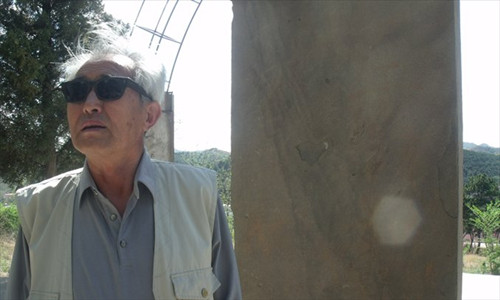
Peng Mingsheng stands by a monument at a hillside in Chengde, Hebei Province, which marks the mass grave of 36,000 people killed during the Japanese occupation from 1933-45 in the city. Photo: Zhang Yiwei/GT
Climbing up concrete steps past modest bungalows scattered along the pathway, up to a barren hillside covered with weeds, on a cramped clearing where a shabby unmarked monument tainted by scrawls stands, a white-haired man shakes his head and sighs, "No one even cares about this place."
Located in Chengde, Hebei Province and about 230 kilometers northeast of Beijing, this is a mass grave where the remains of at least 36,000 people killed by invading Japanese troops during their occupation from 1933 to 1945 are kept.
Peng Mingsheng, a 75-year-old retiree in Chengde, has devoted almost half his life to researching the mass grave in the city, which used to be annexed as part of the Manchurian puppet state during the Japanese occupation.
Nearly 30 years have passed since he began his research. Although He has been calling on local authorities to set up a cemetery to better protect the site and commemorate the people killed for defying or fighting Japanese rule, the mass grave is still a barren wilderness, with a growing number of private buildings encroaching on the site.
"Japanese right-wing politicians have still been openly denying Japanese wartime atrocities recently. We must keep the evidence of their crimes," he said.
Sense of obligation
As a senior policy advisor at the Chengde Party History Research Center, Peng was assigned the task of studying the mass grave in 1984. Before that, Peng had never been involved in history-related work, but his commitment to it has continued ever since.
"At first, I didn't have much of an impression of the mass grave," Peng said. "But after I began my research by visiting families of the deceased victims, I feel a strong obligation to ensure that the historical facts of the mass grave are sorted out clearly. The people I visited, mostly aged 60 to 70, wept out their grief to me, and I got to know how tragically they suffered from the war."
During the research, Peng traveled across different provinces to visit the survivors, families of the victims and those who served the puppet regime, as well as to scour historical archives in libraries and even the State Archives Administration, where he was given access to confidential files.
Peng organized all the materials and wrote the book Zui Zheng (Evidence of Crimes) published in 1996, recording the cruelty of the massacres in China. Japanese soldiers frequently beheaded Chinese people who were carried in dozens of vehicles one by one for hours on end. When Japan surrendered in 1945, people found bones all over the area.
After retiring in 1997, Peng still devoted himself to raising awareness of the existence of the mass grave and its protection by giving speeches in schools, companies and government agencies. He has received some 70 Japanese people over the past 20 years who visited the site after they learned about Peng's investigation.

Copyright ©1999-2011 Chinanews.com. All rights reserved.
Reproduction in whole or in part without permission is prohibited.